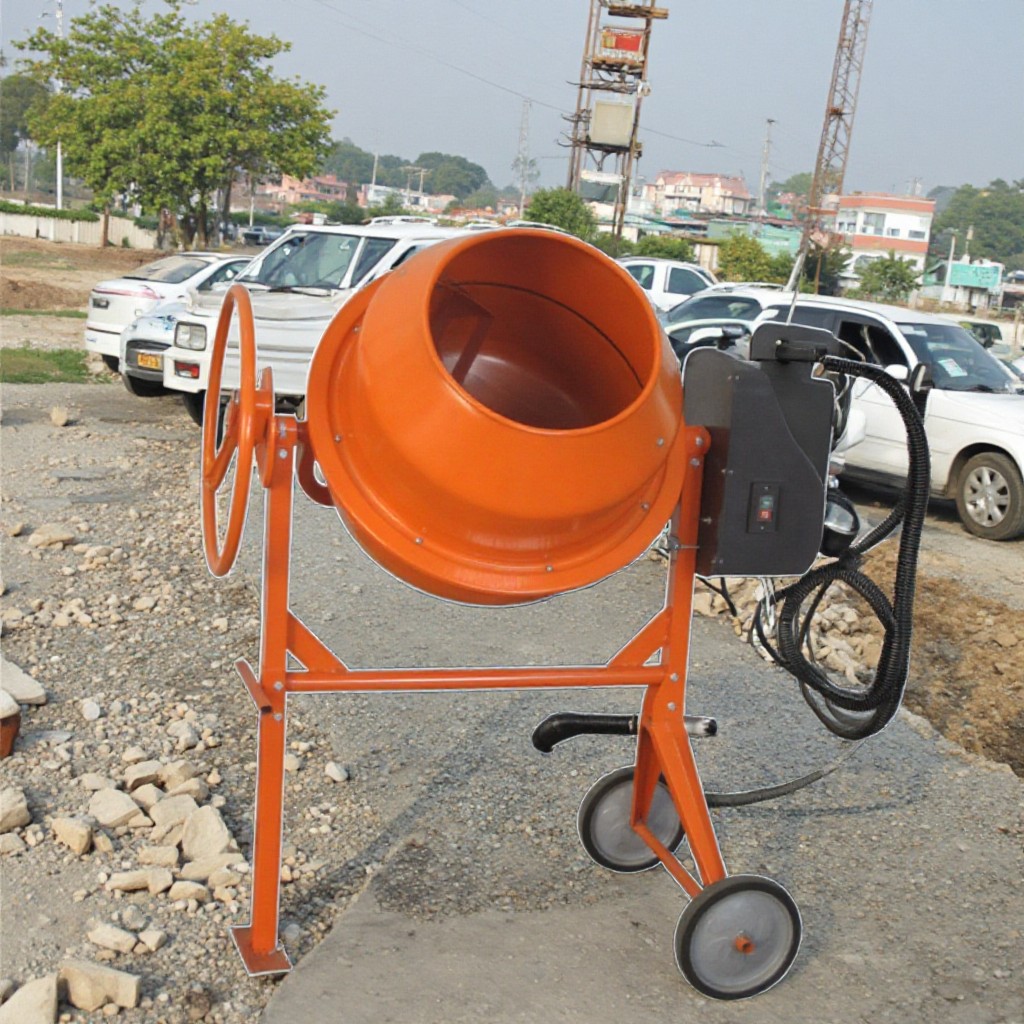Portable Cement Mixer Buying Guide: 15 Must-Know Facts for Smart Construction
Home » Portable Cement Mixer Buying Guide: 15 Must-Know Facts for Smart Construction

Table of Contents
1. Introduction to Portable Cement Mixers
Portable cement mixers are essential for construction, repair, and DIY projects. These machines combine sand, gravel, water, and cement into a consistent concrete mix, making them indispensable on small to medium-sized job sites.
Whether you’re laying a driveway, building a patio, or managing construction for a small business, the portable cement mixer is your best bet for efficiency and convenience. They’re especially useful when ready-mix deliveries are too costly or impractical.
2. Why Use a Portable Cement Mixer?
Here’s why builders and homeowners prefer portable cement mixers:
Time Efficiency: You can mix on-site and on-demand, cutting wait times.
Labor Reduction: Minimizes manual mixing with shovels or wheelbarrows.
Consistent Quality: Ensures a uniform mix every time.
Cost-Saving: Reduces reliance on pre-mixed concrete services.
Portable cement mixers are built to be user-friendly, low-maintenance, and energy-efficient. Most importantly, they allow you to work at your own pace.
3. Types of Cement Mixers: Which One’s Right for You?
Choosing the right type of mixer depends on your project size, frequency of use, and budget.
3.1 Drum Mixers
These are the most common type of portable cement mixers. A rotating drum blends the materials inside.
Best for: Homeowners and small contractors.
Pros:
Simple operation
Low cost
Easy to clean
3.2 Pan Mixers
These use a stationary pan with rotating blades and are typically used for more viscous materials.
Best for: Industrial-grade mixing tasks.
Pros:
Faster mixing
Better for mortar and specialty concretes
3.3 Tilting vs Non-Tilting Models
Tilting models allow you to pour the mix directly from the drum. Non-tilting mixers require manual scooping.
Choose tilting if:
You want less manual labor
You mix in larger batches
4. Key Components of a Cement Mixer
Understanding the components helps you evaluate quality:
| Component | Function |
|---|---|
| Drum | Mixes materials thoroughly |
| Motor | Powers rotation |
| Frame | Provides stability |
| Paddles | Help with material agitation |
| Wheels | Enable easy movement |
High-quality mixers will have powder-coated or rust-resistant frames, sealed motors, and weatherproof controls.
5. How to Choose the Right Drum Capacity
Cement mixer capacity is measured in cubic feet or liters. Consider:
| Project Type | Recommended Drum Size |
|---|---|
| DIY/Small Jobs | 2-5 cu. ft. |
| Mid-size Projects | 6-9 cu. ft. |
| Professional Use | 9-12+ cu. ft. |
Tip: Don’t fill the drum completely. Always allow space for proper mixing and movement.
6. Power Sources: Electric vs Gasoline Mixers
Let’s compare your two main power options.
| Feature | Electric Mixer | Gasoline Mixer |
|---|---|---|
| Noise | Quieter | Louder |
| Emissions | Zero | Emits fumes |
| Usage | Indoor/outdoor | Outdoor only |
| Startup | Push-button | Pull-start |
| Maintenance | Low | Higher |
Choose electric for indoor use or residential areas. Use gasoline for off-grid or high-power outdoor jobs.
7. Portability Features That Matter
A portable cement mixer is only as mobile as its design allows. Look for:
Sturdy wheels: Pneumatic or solid rubber tires
Lightweight frame: Aluminum or reinforced plastic
Folding handles: For easier transport
Compact size: Easier storage
Some models come with tow bars for ATV or tractor towing, ideal for farms or remote locations.
8. Mixer Frame & Build Quality
The frame needs to withstand vibrations and outdoor exposure.
Material: Powder-coated steel resists rust
Welds: Look for smooth, consistent welds
Weight: Heavier models resist tipping but are harder to move
Well-constructed frames ensure safety, longevity, and better performance.
9. Safety Features You Shouldn’t Ignore
When dealing with cement mixers, safety is non-negotiable. These machines may appear simple, but improper handling can lead to injuries or property damage. Always consider the following safety features when purchasing:
Emergency shut-off switch: Instantly cuts power in case of emergencies.
Motor guards: Prevents accidental contact with hot or moving parts.
Locking mechanisms: Secure the drum during mixing or transport.
Anti-tip design: Wide stance and low center of gravity for stability.
Overload protection: Prevents motor burnout due to excessive load.
Additionally, you should always wear protective gloves, safety glasses, and non-slip footwear during operation. Many newer models include circuit breakers and splash guards, which reduce the risk of electrical shock or concrete splatter.
10. How to Use a Portable Cement Mixer Properly
Even the most advanced mixer won’t help if used incorrectly. Here’s a step-by-step guide for best results:
Step-by-Step Mixing Process
Prepare Materials: Measure cement, sand, gravel, and water before use.
Start Mixer: Power on and let the drum rotate.
Add Water: Add only part of the water first.
Add Cement & Aggregates: Slowly shovel in dry ingredients.
Add Remaining Water: Add slowly until desired consistency is reached.
Mix for 3–5 minutes: Until the mixture is uniform.
Discharge Mix: Tilt the drum or use the release handle.
Mixing Tips
Do not overfill the drum.
Avoid stopping mid-mix.
Clean immediately after use to prevent hardened buildup.
A properly used portable cement mixer saves time and enhances the final quality of your concrete.
11. Maintenance Tips for Long-Term Use
Maintaining your mixer ensures durability and consistent performance. Follow these maintenance tips:
After Each Use
Rinse drum thoroughly with water.
Scrape any remaining cement with a trowel.
Dry the drum to prevent rust.
Weekly
Check bolts and fasteners for tightness.
Inspect wiring for wear or exposure.
Lubricate moving parts like wheels and pivots.
Monthly
Deep clean drum with a mix of gravel and water.
Test emergency stop and other safety features.
Keeping a maintenance log can help detect recurring issues early. Most well-maintained portable mixers can last 5–10 years or more.
12. Cost Breakdown: Budget to Professional Options
The cost of a portable cement mixer can vary widely depending on capacity, brand, and features.
| Category | Price Range | Best For |
|---|---|---|
| Budget | $150–$350 | DIYers, occasional use |
| Mid-range | $350–$800 | Small contractors |
| Professional | $800–$2000+ | Daily commercial use |
Don’t just go by price—assess durability, motor strength, and drum capacity. Some budget mixers may look appealing, but they might not handle repetitive, heavy-duty use.
Hidden Costs to Watch For
Replacement parts
Extended warranties
Maintenance tools
Shipping (especially for heavier units)
13. Top Brands & Models in 2025
Here are some top-rated portable cement mixers making waves in 2025:
| Brand | Model | Capacity | Type | Price |
|---|---|---|---|---|
| Kushlan | 350DD | 3.5 cu. ft. | Electric Drum | $450 |
| YARDMAX | YM0115 | 4.0 cu. ft. | Electric Drum | $399 |
| Stark | 67035 | 5.0 cu. ft. | Electric Drum | $329 |
| Imer USA | Minuteman II | 5.0 cu. ft. | Electric Drum | $899 |
| DIMEC | PME-CM350 | 12.3 cu. ft. | Gas Drum | $900 |
Pro Tip: Stick to known manufacturers like Kushlan, Imer, YARDMAX, or DIMEC. Their machines tend to last longer, have better support, and offer accessible replacement parts.
14. User Reviews and What They Reveal
User reviews can offer insights into a product’s real-world performance. Here’s what verified buyers often highlight:
Pros Mentioned
Quick assembly
Smooth operation
Sturdy frame
Quiet motor
Great for small foundations and patios
Common Complaints
Noisy motors on budget models
Shorter power cords
Inadequate packaging on delivery
Drum clogs if not cleaned promptly
Reading reviews on platforms like DIMEC, Amazon, or professional contractor forums helps verify marketing claims. If possible, ask for video demos or user testimonials.
15. Environmental Considerations and Eco-Friendly Use
Concrete mixing isn’t usually associated with sustainability—but that’s changing. Consider these eco-friendly practices when using your mixer:
Use recycled aggregates like crushed concrete or glass.
Reduce water waste by calculating your mix ratios precisely.
Use solar generators for powering electric mixers.
Choose low-emission motors or electric units over gasoline models.
Properly dispose of cement waste to avoid clogging drainage systems.
Some manufacturers now offer mixers made with recycled steel and energy-efficient motors, helping lower your project’s carbon footprint.
FAQs
1. How long can I run a portable cement mixer continuously?
Most electric models can run for up to 30–60 minutes continuously. Let the motor cool down between sessions for longevity.
2. Can I mix mortar or plaster in a cement mixer?
Yes, but use a pan mixer or drum with paddles for better results. Clean thoroughly afterward to prevent contamination between mixes.
3. Are portable cement mixers weatherproof?
Not fully. While many are water-resistant, prolonged exposure to rain or snow can damage motors and electronics. Always store indoors or under a tarp.
4. What size mixer do I need for a patio?
A 5–6 cu. ft. drum is ideal for medium-sized patios. It balances batch volume with manageable weight.
5. How loud are these mixers?
Electric mixers range from 60–80 dB, about as loud as a vacuum cleaner. Gas mixers are typically louder (85–100 dB).
6. Can one person operate a portable cement mixer?
Yes. Most are designed for single-person operation, though larger models might require help with loading and moving.
Conclusion
Choosing the right portable cement mixer is a game-changer for any construction, renovation, or DIY project. With the right size, power source, and features, you’ll mix faster, waste less, and achieve professional-grade results.
From drum capacity to eco-friendliness, each element plays a crucial role. Whether you’re a weekend DIYer or a full-time contractor, investing in the right mixer pays off in efficiency, quality, and cost savings.
For best results, compare top brands, read user reviews, and always prioritize safety and durability.
Small Construction Equipment Specialist
About the author

Amber Lu
General Manager | Wuxi Pinnacle Mechanical Equipment Co., Ltd. (PME)
Specialist in Compact Construction Machinery & International Trade
As General Manager of PME, I bring over 15 years of expertise in compact construction machinery and global trade. I have worked extensively with medium to large companies worldwide, providing professional support and customized solutions across diverse markets.
With in-depth product knowledge of plate compactors, tamping rammers, floor saws, concrete vibrators, engines, and power equipment, I lead PME’s international expansion and customer service strategy. My experience covers the full trade process—from pre-sales consultation and order coordination to after-sales service—ensuring efficiency and customer satisfaction.
Backed by a skilled technical team and complete in-house production capabilities, I am committed to driving product quality, innovation, and long-term partnerships across more than 68 countries.
You May Also Like
